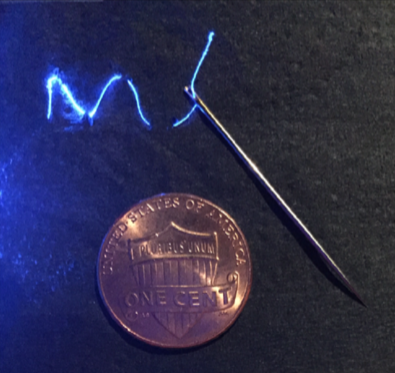By Kimberley Patterson
The idea of neural fibre implants to fix spinal injuries causing paralysis is not new news when it comes to research[1-3]. There are several problems that researchers have needed to overcome in this area, such as the biocompatibility, flexibility, and durability of the implants.
Recently, a research group from MIT, in collaboration with University of Washington, and Oxford University, published an article which used transparent optic fibres coated in silver nanowires (AgNWs) to potentially solve a few of these issues[4]. The fibres were designed to stimulate and monitor the spinal cord for the purpose of rehabilitating paralysis caused by injuries. Said to be inspired by other research[4] where flexible optical and electrical stimulation probes have shown promising results for the future, this group has made progress[5, 6] in this field over several years. In this paper, they have added to the progress by producing their ‘hybrid’ fibres.

Once the research group had manufactured this transparent fibre, they put it to the physical test; characterising electrical impedance, optical transmission for mechanical properties to determine resilience of the probes to stretch and strain simulating that the probes would experience by common spinal movements in mice.
Comparison fibres were made with either conductive copolymers, which are extremely flexible but limited by high impedance, or solid metallic conductors, which have the opposite issue where they have low impedance but are prone to cracking [4]. The AgNWs hybrid probes showed resilience to strain, by stretching by 20-30 % while keeping conductivity and low impedance, performing overall better than solid metallic and copolymer structures.
Further testing with in vivo electrophysical recording and optical stimulation of the wires in mice, evoked neural activity in the spinal cords. Surrounding tissue was also analysed for evidence of the AgNWs producing corrosion and cytotoxic effects to the mice, which was not evident in the vicinity of the implants. This is a good start to the stimulation of nerves for paralysis rehabilitation and the biocompatibility of the probes.
With these positive first steps, this fibre platform may one day allow the monitoring and controlling of neural activity.
Full Journal Article: http://advances.sciencemag.org/content/3/3/e1600955
References:
[1] A. M. Stolyarov, L. Wei, F. Sorin, G. Lestoquoy, J. D. Joannopoulos, Y. Fink, Fabrication and characterization of fibers with built-in liquid crystal channels and electrodes for transverse incident-light modulation. Appl. Phys. Lett. 101, 011108 (2012)
[2] S. I. Park, D. S. Brenner, G. Shin, C. D. Morgan, B. A. Copits, H. U. Chung, M. Y. Pullen, K. N. Noh, S. Davidson, S. Ju Oh, J. Yoon, K.-I. Jang, V. K. Samineni, M. Norman, J. G. Grajales-Reyes, S. K. Vogt, S. S. Sundaram, K. M. Wilson, J. S. Ha, R. Xu, T. Pan, T.-i. Kim, Y. Huang, M. C. Montana, J. P. Golden, M. R. Bruchas, R. W. Gereau IV, J. A. Rogers, Soft, stretchable, fully implantable miniaturized optoelectronic systems for wireless optogenetics. Nat. Biotechnol. 33, 1280–1286 (2015). 6.
[3] I. R. Minev, P. Musienko, A. Hirsch, Q. Barraud, N. Wenger, E. M. Moraud, J. Gandar, M. Capogrosso, T. Milekovic, L. Asboth, R. Fajardo Torres, N. Vachicouras, Q. Liu, N. Pavlova, S. Duis, A. Larmagnac, J. Vörös, S. Micera, Z. Suo, G. Courtine, S. P. Lacour, Electronic dura mater for long-term multimodal neural interfaces. Science 347, 159–163 (2015).
[4] [Main Article] C. Lu, S. Park, T. J. Richner, A. Derry, I. Brown, C. Hou, S. Rao, J. Kang, C. T. Mortiz, Y. Fink, P. Anikeeva, Flexible and stretchable nanowire-coated fibers for optoelectronic probing of spinal cord circuits. Sci. Adv. 3, e1600955 (2017).
[5] C. Lu, U. P. Froriep, R. A. Koppes, A. Canales, V. Caggiano, J. Selvidge, E. Bizzi, P. Anikeeva, Polymer fiber probes enable optical control of spinal cord and muscle function in vivo. Adv. Funct. Mater. 24, 6594–6600 (2014).
[6] Multifunctional fibers for simultaneous optical, electrical and chemical interrogation of neural circuits in vivo. Nat. Biotechnol. 33, 277–284 (2015).


Thanks for this wonderful post